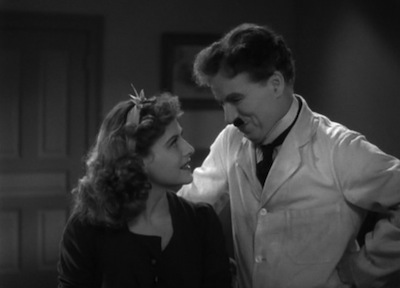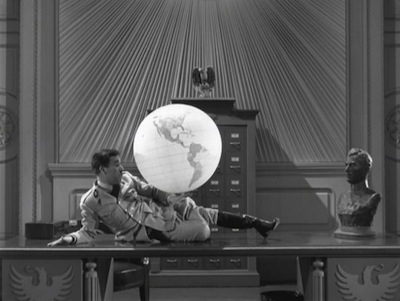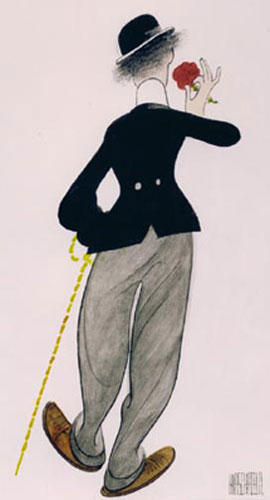
A little historical perspective: In 1937, though Adolph Hitler's power was growing and his unctuous policies were becoming increasingly well-known, the world was not yet at war with Germany. On the contrary, until late that year, Hitler was still in negotiations with England to try to maintain an alliance across Europe. So, it was with some incredible foresight and more than a little guts that Charles Chaplin, the biggest movie star in the world, began filming The Great Dictator, a satirical send-up of the hated world leader and everything he stood for. Who knows what the reaction to the film would have been had it been released earlier than 1940, but Chaplin's notoriously slow shooting schedule meant that the world had time to catch up before The Great Dictator was completed. By that juncture, the tide had turned and the movie hit at just the right time. In fact, following Germany's invasion of France, Chaplin rewrote his ending, changing it to the now famous call to arms. The Great Dictator would have been a remarkably different movie without it.
Though The Great Dictator wasn't Chaplin's first motion picture with sound--1936's Modern Times [review] was shot with minimal recorded dialogue but it was ostensibly made like a silent--it is considered his first full-on talkie in that it's his first with scripted dialogue from start to finish. For the occasion, Chaplin cast himself in two roles: a Jewish barber suffering persecution in the ghetto of the fictional country of Tomania, and Adenoid Hynkel, the cruel Phooey (a play on "Führer") making everyone's life miserable. Adenoid Hynkel is said to have come to life when Alexander Korda pointed out to Chaplin that his Tramp character had a very similar moustache to Adolph Hitler. Indeed, this similarity will be exploited in the final scenes of The Great Dictator when the two characters are mistaken for one another. (Though Dictator is not considered a Tramp picture per se, Chaplin does wear the outfit and keeps the rectangular nose neighbor.)

Most of Tomania is invented, even if the characters have real-life analogues. The base of the parody rests in silly puns and slapstick. Hynkel's right and left-hand men are Herr Herring and Herr Garbage; his ally and rival from the country of Bacteria is Benzino Napoli. The two despots fight over the right to invade Osterlich (most often pronounced like the bird "ostrich"). Hynkel's party has a logo comprised of two Xs, known as the Double Cross. When the dictator slips into fake German, it's mostly gibberish, with words like "sauerkraut" and "schnitzel" mixed in. It's not subtle comedy, to be sure, but it's damn funny. In particular, our first view of Hynkel is him leading a large rally and addressing his minions. Chaplin has clearly studied Hitler's speeches and catalogued his gestures and verbal idiosyncrasies. He shouts and flails and snorts and spits, breaking the rant for goofy pantomimes with a water pitcher, including dumping a glass in his pants. Later, he and Benzino Napoli (Jack Oakie) get in a food fight. It's humor that both plays to the audience's expectations and serves a purpose: the idea is to make these horrendous men seem as ridiculous as possible, and by doing so, deflate their power. The greatest compliment you can give them is to take them seriously.
Chaplin saves the serious stuff for the other plot, the Jewish ghetto where the barber toils under threat of having his head bashed in by stormtroopers. Chaplin's character is a hero from World War I who has been laid up in hospital with amnesia since that conflict ended, and he returns to life in Tomania unaware of the Double Cross. He quickly runs into trouble with Hynkel's thugs, though a pretty girl's frying pan and providence get him out of it. The pretty girl is a neighbor played by Paulette Goddard, and though somewhat underdeveloped, the romantic B-plot adds a sweetness to The Great Dictator. There is a charming sequence where the barber experiments with being a beautician, and he helps Goddard look and feel like a woman for the first time in her life. It's quite touching. Chaplin smartly knew that his movie needed heart to win over its audience. People react better to fighting for something specific, like the man or woman they love, than they do larger concepts. The masses can preserve the big ideas, but only you can protect what's important to yourself.

Otherwise, there isn't much sugarcoating in terms of how the ghetto is portrayed--you know, excepting the slapstick chases through the streets. Hynkel's men paint the word "Jew" on the windows of shops with Jewish owners, they freely steal from their victims, and the threat of concentration camps loom. While, granted, we know now how much worse the ghettos and the camps were than what Chaplin depicts in the movie, the full extent of the atrocities were not yet known during production. Even so, it's bold to present the anti-Semitism as it was and not dress it up in cute language or gags. The filmmaker was not looking to hide the film's message. He wanted his opinion of Hitler and Nazi policy to be very clear. Sure, some of it is heavy handed, just as some of the dialogue and supporting performances are clumsy--for all his craft, talkies still weren't Chaplin's thing. Unsurprisingly, The Great Dictator's most beloved sequence is the private ballet Hynkel undertakes with a balloon globe. Here the satire actually gets far more subtle, a dark message delivered in the lightest and most delightful manner possible: such capricious treatment of the world will only lead to its destruction.

I think Chaplin can be forgiven for the bluntness of the propaganda. It was a different time, and different measures were required. The closing speech, in particular, must have felt absolutely crucial. The Jewish barber appeals to people of all nations, resorting to few of the histrionics his twin is known for, letting the import of the words do most of the work. The delivery is emphatic, with Chaplin looking directly into the camera, rallying the brotherhood of man to come together for a brighter tomorrow. It would be easy to be cynical and crack wise and minimize the scene if it weren't still so poignant, still so right on. For as stirring as it is, it's also rather sad that the message is no less true today than it was seventy years ago. Sinister forces still work to enslave us, man still betrays his own best interests to fuel the global machine, and the warnings Captain Schultz (Reginald Gardiner) gives to Hynkel could just as easily be applied to Guantanamo Bay and waterboarding. The deadly folly concocted by cruel minds appears to be history we are doomed to repeat.
Hell, it might even be worse now. Could you imagine any studio ever greenlighting a film like The Great Dictator today, much less a star of Chaplin's power signing on for the project? Try to imagine Jim Carrey playing Saddam Hussein or Ben Stiller as Osama Bin Laden during the early days of the so-called War on Terror.* It never would have happened. We don't have the guts to laugh that way anymore. Too many people would be offended for too many reasons. Is that maybe the cruelest, most divisive trick of all? If we can't laugh together, we can never join together to truly be free.
Criterion continues to use Blu-Ray technology to their best advantage with another stellar release: the new HD transfer on The Great Dictator looks remarkable. The surface image is clean, the resolution is sharp, and the black-and-white is perfectly rendered, with excellent balance between light and dark. I suppose one day I will turn cynical and these impressive restorations will start to look like old hat, but right now, I'm still overwhelmed by what can be done with classic films.
The bonus section is packed with a lot of great extras, including a new scholarly commentary and two video essays taking a more in-depth look at the movie. In addition to this, we get the intriguing TCM documentary The Tramp and the Dictator, which examines the movie and the parallels between Chaplin and the man he was lampooning.
There are also some fun comparisons of different barbershop scenes from earlier Chaplin movies, material that served as foundation for similar sequences in The Great Dictator.
Most pleasing, however, is the inclusion of the wonderful Al Hirschfeld drawings from the original Great Dictator press book. Criterion reprints them inside the supplemental booklet that comes with this release, alongside vintage essays about the movie and its final speech. Though not part of that old program, I can't help but enjoy the Hirschfeld portrait of Chaplin below, and so I share it here:

* South Park, of course, proves a notable exception to the rule. Sacha Baron Cohen is also currently in production on a Saddam Hussein movie, and it will remain to be seen if there is enough safe distance. The moviegoing public may still reject such a thing if the tone is too light.
This disc was provided by the Criterion Collection for purposes of review.

1 comment:
"Try to imagine Jim Carrey playing Saddam Hussein or Ben Stiller as Osama Bin Laden during the early days of the so-called War on Terror."
Not a very good comparison. America hadn't joined the war in 1940, so Chaplin's film is in part a protest against inaction, not simply a jingoistic send-up of an wartime enemy.
A better comparison might be "Try to imagine Jim Carrey playing Omar al-Bashir or Ben Stiller as Bashar al-Assad today." That gets at the discomfort level rather better.
Post a Comment